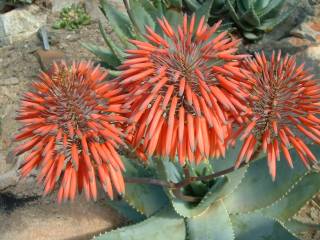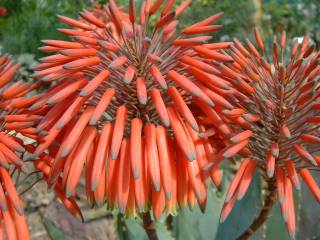Aloe mitriformis
Aloe mitriformis Mill.
Family: Asphodelaceae
Common names: mitre aloe (Eng.); krans aalwyn (Afr.)
Introduction
There are not many aloes from the Cape that flower during summer, hence those that do are more sought after. Those of you who love gardening with bright reds, oranges and yellows will find this particular aloe quite irresistible. Aloe mitriformis is a true Cape mountain and winter-rainfall species that has a lot more to offer than just pretty flowers.

Description
Description
In its natural habitat, the plants have long and creeping stems that often have secondary side shoots along their length. Instead of making upright stems, they tend to follow a sprawling habit with prostrate stems reaching up to 2 m long. These typically lie along the ground with only the terminal, leaf-bearing portion being erect.The leaves, are arranged in rosettes (circular leaf attachments), may spread erectly or curve inward. They are thick and fleshy and have a bluish-green colour. Plants that are in full sun often have more bluish leaves than those that are in shady areas which have more dark green leaves. Also, plants that are fully exposed have a tighter leaf arrangements compared to the more spaced leaves on shaded specimens. The leaf margins are armed with harmless, small white teeth, which turn yellow to dark brown as leaves become older.
A. mitriformis occurs mostly in groups and also may grow down vertical cliffs. In the latter position, plants will have thinner stems with smaller leaves to avoid breaking caused by gravitational weight. A. mitriformis is a particularly fast-growing, tough and adaptable species that easily copes with the elements.
The flowers are dull to bright red and appear in dense arrangements on the branched stalks. Up to five flowering branches may be present at one time. The shape of the racemes varies from cone-shaped to head-shaped or rounded. These aloes flower in summer from December to February.

Conservation Status
Status
Aloe mitriformis is found in abundance in almost all the mountainous parts of the Western Cape. The species is probably the most typical of all the creeping aloes and is certainly not threatened.
Distribution and habitat
Distribution description
The natural home of A. mitriformis is the Western and Northern Cape from near Genadendal in the south to the Bokkeveld Mountains near Nieuwoudtville in the north. It typically occurs in mountainous areas at altitudes of 1 200 m to 1 500 m. It prefers flat, rocky places although it is not uncommon on vertical cliff faces.
A. mitriformis has a preference for well-drained, sandy soils with a slight acidic pH and low humus level. The plants favour mild to hot summers and easily survive occasional snow in the rainy season, which is from April to July.
Plants are found characteristically among rubble-like sandstone slabs and rock, hence the other unofficial Afrikaans common name, puin aalwyn, meaning rubble aloe.
Derivation of name and historical aspects
History
This aloe has been known under a number of different names recently; Aloe perfoliata, Aloe ferox and Aloe microstigma. To avoid confusion we are retaining the name Aloe mitriformis until the matter is resolved. Aloe mitriformis is so named because of the resemblance of its rosette to a mitre or bishop's cap especially in times of drought.
The genus name Aloe is derived from the Arabic, alloch, and translated as allal in Greek and Hebrew, literally meaning bitter or bitter sap which is descriptive of Aloe sap.
A. mitriformis is one of seven aloes with distinctive creeping stems. All species of creeping aloes flower in the dry summer months and occur in the Northern, Western and Eastern Cape. It is noteworthy that five of the seven creeping aloes are threatened in one or the other way.
The genus Aloe is undergoing extensive revision with many species having been placed in new genera.
Ecology
Ecology
Aloe mitriformis is pollinated by sugarbirds as well as insects like ants which are small enough to enter the flower tube in which the nectar is stored. After fertilization, the fruit, which is a capsule, grows quickly and splits into three parts at the end of the summer. The seeds are small, up to 4 mm and slightly winged, enabling them to be dispersed by the wind. Pieces of the stem that break off also root easily when in contact with the ground.
The plant in itself is very tough and can often survive for several seasons without water, at which point the leaves turn a reddish colour, a sign generally associated with stress.
Groups of A. mitriformis are often found in places inhabited by rock hyraxes otherwise known as dassies ( Procavia capensis ). The droppings of these cuddly looking mammals, whose closest relative are elephants, can easily be seen in close proximity to colonies of A. mitriformis and Kumara plicatilis, previously known as A. plicatilis (fan aloe). It is a known fact that the roots and stems of these plants serve as a source of moisture or food.
Uses
Use
Klipspringer ( Oreotragus aoretragus ) and dassies occasionally eat the roots and stems of the plant.
While there are no records of this particular species as a food source for humans, the yellow bitter sap in the leaves, as with other aloes, can be used as a laxative and to heal wounds.
The horticultural value of A. mitriformis in gardens goes without saying. It is a very well-known and established plant in horticulture.
Growing Aloe mitriformis
Grow
For smaller gardens the plants can be used in deep plant boxes or pots. The ideal garden situation is of course when they are planted in a group of ± 20 plants. For optimal flowering, remember to plant A. mitriformis in the full sun. Raised rock gardens that allow good drainage are the best situations for these plants. Embankments and retaining walls are also perfect, as the pants will naturally tend to creep and can cover large areas especially if you have a difficult or unsightly spot in the garden.
Growing A. mitriformis is very easy. The best results are achieved by simply making stem cuttings. Allow cuttings to dry for a few days and insert into river sand and keep moist. The roots appear after about two weeks.
Seeds must be sown as fresh as possible. When kept too long they are parasitized by small crawling insects. The best time for sowing would be in the winter, June to July. Use coarse river sand and cover seeds lightly, then keep moist. It is advisable to treat seeds with a long-lasting fungicide, as seedlings are prone to damping off, a fungus that eventually kills the young plants. Simply shake seeds in a container with some fungicide. After germination, when plants are about 20 to 30 mm, plant over using a sandy-loam medium and feed with organic-based fertilizer at least once a month to ensure healthy growth. If you have a garden with clay soil, use some agricultural lime and bone meal to break up and nourish the soil.
Mature plants in the garden may from time to time be subjected to attack from scale insects and aphids. For scale insects, an oil-based solution can be used, even soap water has proven effective against scale and the best results are obtained by physically removing scale using a cloth. Contact insecticides for insect usually work well but in heavy infestations a systemic application may be necessary. All known garden pests can be kept to a minimum by simply ensuring optimal growing conditions and a good selection of plants that attract wildlife to your garden.
Companion plants to A. mitriformis include A. comptonii, A. distans, A. falcata, Lampranthus multiradiatus, L. aureus and many of the Bulbine species. For groundcovers consider Gazania krebsiana, Hermannia saccifera, Lampranthus reptans Oscularia deltoides and Pelargonium myrhifolium. Larger succulents such as Tylecodon paniculatus, Cyphostemma juttea and Cotyledon orbiculata are also fantastic choices.
References
- Stearn, W.T. 2003. Stearn's dictionary of plant names for the gardener. Cassel, UK.
- Van Wyk, B-E. & Smith, G. 1996. Guide to aloes of South Africa. Briza Publications, Pretoria.
Credits
Werner Voigt
Kirstenbosch NBG
July 2005
Plant Attributes:
Plant Type: Succulent
SA Distribution: Northern Cape, Western Cape
Soil type: Sandy, Clay
Flowering season: Early Summer, Late Summer
PH: Acid
Flower colour: Red
Aspect: Full Sun
Gardening skill: Easy
Special Features:
Horticultural zones











Rate this article
Article well written and informative
Rate this plant
Is this an interesting plant?
Login to add your Comment
Back to topNot registered yet? Click here to register.